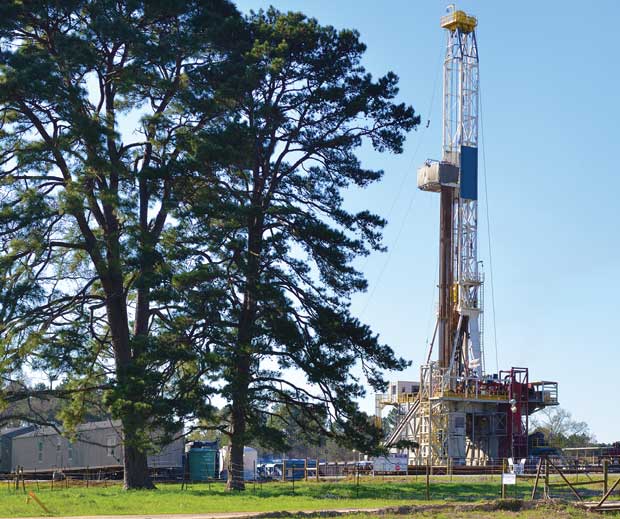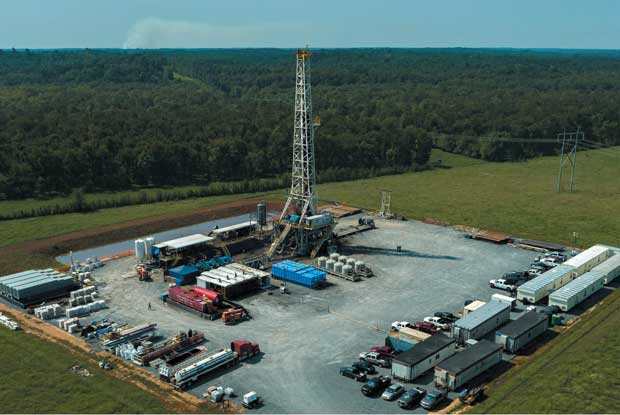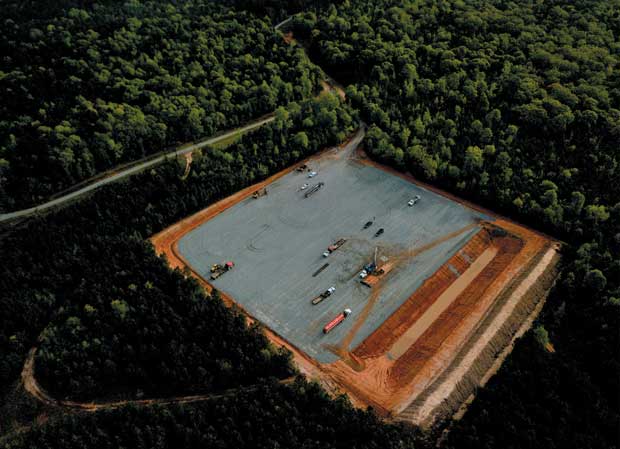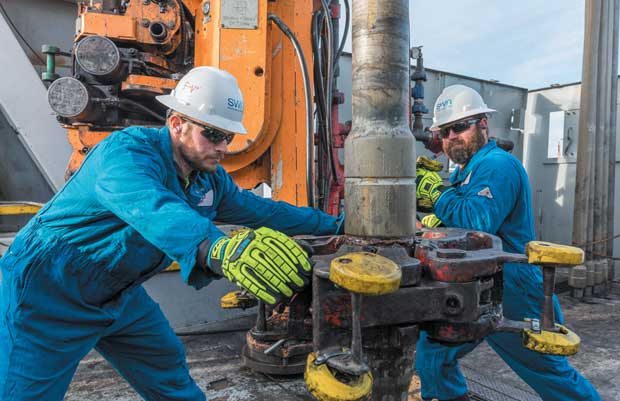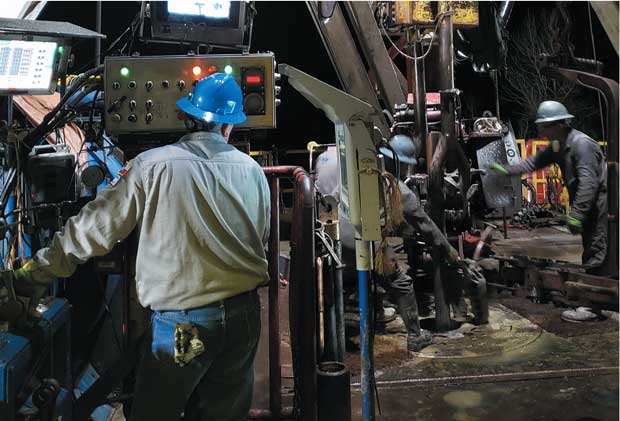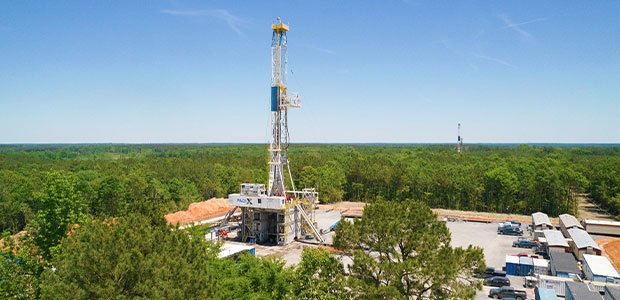
Haynesville In Sweet Spot As Domestic Demand Climbs, U.S. LNG Exports Soar
By Danny Boyd, Special Correspondent
Henry Hub spot prices have averaged their highest nine-month run in seven years. Much has changed since 2014, and both U.S. natural gas demand and production have expanded by trillions of cubic feet a year.
A major factor driving both sides of the supply and demand equation is liquefied natural gas exports. Recent projections from the U.S. Energy Information Administration pegged average LNG exports at an average 11.5 billion cubic feet a day in 2022, making the United States the largest LNG exporter on the planet. And that was prior to Russia’s invasion of Ukraine.
Not surprisingly, Haynesville dry gas producers are upbeat about the economics underpinning the market and their increasingly prominent role in keeping it supplied. With the world still coming to terms with Russia, the very real possibility exists that the Haynesville and other U.S. gas shale plays will be called on to help fill the energy needs of America’s allies.
Long-Term Position
As a 15-year Haynesville player backed by the latest technologies to identify and enhance prospects across a 372,000 net-acre position, Comstock Resources Inc. continues to improve an overall drilling inventory capable of sustaining the current development rate for the next 25 years, says Chairman and Chief Executive Officer M. Jay Allison.
A tally of 1,953 net locations in inventory at the end of 2020 has been reduced to 1,633, a change from being able to extend lateral lengths by 25% as the company moves aggressively to enhance efficiencies from laterals that now extend beyond 15,000 feet in some cases.
The enhancements are a crucial part of the Frisco, Tx.-based company’s mission to ensure a long drilling lifespan with inventory capable of creating predicable results, Allison says.
“The total lateral feet of our drilling inventory increased to 13.9 million feet from 13.4 million at the end of 2020. More importantly, we increased the returns on the future wells by reducing the numbers of wells required to be drilled by increasing the average lateral length,” he comments.
Laterals on 44 locations in inventory were lengthened from a $35 million bolt-on acquisition of 17,331 net acres in East Texas last year, adding almost 60 net drilling locations at closing in December.
Included in Comstock’s drilling inventory are 301 Haynesville and Bossier net locations that can be drilled with laterals longer than 11,000 feet, and lateral lengths on 902 net locations will be 8,000 feet or longer.
By mid-December, Comstock turned its first two Haynesville wells with 15,000 foot laterals to sales. The combined IP of the Talley 32-29-20 Nos. 1 and 2 wells in DeSoto Parish was 89 million cubic feet a day from the Haynesville.
The company has extended lateral lengths methodically, going from 6,200 feet on average in 2017 to a projected average of 10,500 feet this year, assessing drilling and completion technology and results along the way, Allison points out.
With 1,600 long-lateral locations identified, Comstock Resources Inc., has a drilling inventory capable of sustaining its current development rate for 25 years.
Comstock has chosen to use stick pipe over coiled tubing in laterals longer than 10,000 feet to ensure completion predictability, he adds. Proppant volumes are up to about 3,500 pounds a lateral foot.
With a mix of executives that includes some in their 30s and 40s who want to stay on the forefront of technology and older veterans adding seasoned guidance and insight, Allison says Comstock can continue to push the envelope and experience better results, lower costs and higher margins.
Comstock’s inventory is its most valuable asset, he insists, and to exploit its position, the company will devote about $777 million in capital expenditures to keep seven rigs and three frac crews busy developing an expected 55-60 net wells on its acreage. Production is expected to grow 4%-5% this year.
Comstock plans to repay $480 million of debt and have more than $500 million of free cash flow as it contemplates reinstituting a dividend discontinued during learner times, Allison says.
With its Haynesville position, Comstock is sitting in the “catbird seat,” offering low-emissions natural gas for consumption in the United States and to export as LNG from the Gulf Coast export terminals, he points out.
“It is pretty amazing to see the industry transform to shale, understand it, control it and develop the capital discipline to produce it in a responsible way,” Allison remarks. “The natural gas Comstock produces has a low-greenhouse-gas-emissions intensity. I believe it is a responsible energy transition fuel.”
Planned LNG Facility
Houston-based Tellurian Inc.’s business model is a prime illustration of the Haynesville’s upside as a supply basin to the United States and to the world. Tellurian produces gas from a 10,000-acre position in the Haynesville Shale. It also owns Driftwood LNG LLC, which is developing a new LNG export facility on the west bank of the Calcasieu River south of Lake Charles, La.
“Our business model is to source natural gas from the United States, liquefy it, put it on a ship, and market it globally,” says John Howie, president of upstream subsidiary Tellurian Production Company.
In November 2017, Tellurian acquired its Haynesville acreage in a three-way transaction. Following Samson’s sale of its East Texas and Louisiana holdings to Houston-based Rockcliff Energy, Tellurian in turn bought the Louisiana portion of the acreage in DeSoto and Red River parishes from Rockcliff, Howie recalls.
Tellurian Inc.’s Haynesville production is part of an integrated strategy in which the company controls gas molecules from the wellhead to end markets served from its planned Driftwood LNG facility on the Calcasieu River south of Lake Charles, La.
The assets are 95% held by production and 90% operated, allowing the company to control the pace of development for a multiyear drilling inventory, he says. Tellurian plans to keep one rig busy throughout most of this year drilling laterals from 5,000 to 10,000 feet in length, he reports. Tellurian has about 25 active wells and interests in about 75 total, Howie adds, and continually keeps an eye out for bolt-on opportunities in the Haynesville.
To optimize Haynesville completion designs, Tellurian participates in a Haynesville Shale technology consortium that includes engineers, geologists and land management representatives sharing best practices, Howie says.
Despite tightness in service and supply early in the year, the company hasn’t experienced acute shortages, Howie points out. “We are seeing pricing pressure and we are seeing longer lead times to order certain tangible goods, and we have acclimated to that,” he comments. “We are able to access everything we need.”
With the combination of technological advances in drilling and completion techniques and higher commodity prices, the upstream industry in general-and Tellurian specifically-has the wind at its back in the Haynesville, he insists.
“We have both of those things working for us right now,” Howie concludes. “We are pretty happy.”
Packaging Assets
Proving that a smaller company can play in the Haynesville, Shreveport-based EnSight IV Energy Partners LLC continues to acquire, develop and package assets-including a 9,800 net-acre holding currently on the market.
The package includes 79 proven undeveloped locations and 76 MMcf/d of production from 46 wells, says President and Chief Executive Officer George A. Baldwin, Jr.
“We are open to monetizing that if the market values it appropriately,” he says. “From the standpoint of our investment vehicles, with current gas prices, this seems to be a good time to do that. If not, we will hold on to it and develop it further.”
EnSight IV predecessors-comprised chiefly of conventional production-included legacy companies that Baldwin, partner Greg Madden, and other investors sold to Ocean Energy in 2001, Comstock Resources in 2005 and Forest Oil in 2008.
Early on, the group assumed the Haynesville was the exclusive domain of larger companies with deeper pockets, Baldwin says. With economics on the rebound in 2018-19, the company had second thoughts after an internal study considered the impact of changing technologies and the group’s skill at establishing positions with existing production.
EnSight Haynesville Partners was formed to help fund EnSight IV. After acreage trades, the company drilled its first Haynesville well in the third quarter of 2018 and has since drilled 20 operated wells and participated in about 50 others. The secret to amassing a position in the bustling play is to keep looking, Baldwin points out.
Louisiana-based EnSight IV Energy Partners continues to acquire, develop and package assets, including a 9,800 net-acre holding on the market in February. The package includes 79 proven undeveloped locations and 76 MMcf/d of production from 46 wells.
Last year, the company sold a large Haynesville package in the Greenwood-Waskom area along the Louisiana-Texas line. Excluding its position on the market, the group has 200 conventional wells and 4,500 Haynesville acres in Louisiana’s Bossier, Webster, Bienville, DeSoto, and Red River parishes and plans to continue development with an eye on bringing more assets to the market in the future, Baldwin offers.
“Opportunities to acquire acreage will continue to exist as technology, including tighter stage spacing and larger fracs, extends the boundaries of the play,” says Vice President Chris Singletary. Haynesville operators continue to improve drilling and completion efficiencies, he adds.
To maximize the value of its acreage position, EnSight IV continues to drill both dual- and single-section laterals and reap strong results, Singletary says. A pair of single-section lateral wells on a pad in southern Bossier Parish turned to sales Jan. 3, making 20 MMcf/d each, with both averaging about 7,500 psig.
Above-Plan Results
A newcomer to the Haynesville in 2021, Southwestern Energy Company plans to do what it does best across a 257,000-net acre position: utilize expertise honed in Appalachia and elsewhere to accelerate development and improve operating efficiencies, says Chief Operating Officer Clay Carrell.
Southwestern already is realizing gains in the basin from renegotiating arrangements and securing additional future takeaway capacity to the LNG corridor.
“We are off to a good start in the Haynesville, quickly integrating our teams and the acquired assets and delivering above-plan results since starting operations in September,” Carrell says.
Southwestern entered the Haynesville with its $2.7 billion purchase of Indigo Natural Resources, which included 1,000 locations in inventory on approximately 150,000 net acres and estimated daily production this year of 1.1 billion cubic feet equivalent.
Marcellus heavyweight Southwestern Energy Company entered the Haynesville last year with its acquisition of Indigo Natural Resources, and then expanded its position to one of the largest in the play with its acquisition of GEP Haynesville in December. Southwestern plans a 2022 capital budget in Haynesville of almost $1 billion to place 70-75 wells to sales.
In late December, the company added GEP Haynesville in a $1.85 billion deal that provided even more exposure to the LNG export terminals and growing demand centers along the Gulf Coast. GEP came with 700 locations in inventory and 700 MMcf/d of production across a stacked-pay Haynesville and Middle Bossier position.
This year, Southwestern is spending 55% of its nearly $2 billion capital budget in the play, with plans to maintain eight or nine rigs (including two it owns) and three or four frac crews to drill, complete and turn 70-75 wells to sales, Carrell relates.
Fourth-quarter results not reflecting the GEP purchase included seven Bossier and three Haynesville wells with initial production averaging above 26 MMcf/d. Laterals averaged 6,900 feet and cost $1,600 per completed foot, he says, with performance metrics reflecting inherited development plans. Greater drilling efficiencies are expected this year as the company develops its own projects, Carrell says.
The company already is optimizing flowback and completion techniques to confirm Tier 1 reservoir quality, he notes. Additional improvement is expected as the company uses all its technical subsurface data to ensure optimal drawdown and appropriate pressure maintenance on initial IPs, Carrell adds.
“With higher pressures, we are able to see greater rates in the greater commodity price environment that we are experiencing right now without any degradation in EURs or well performance. That allows the IPs to continue to incline as we move forward,” he says.
The company’s actions over the past few years to strengthen overall operations, upgrade inventory, improve cost structure and improve its financial position laid the foundation for its strategic entry into the Haynesville, President and CEO Bill Way told investors in February. He says the move into the Haynesville gives Southwestern Energy a formidable presence in each of the nation’s two premier gas basins: the Haynesville and Marcellus.
“Our strategic entry into the Haynesville was well-timed,” Way says. “Since announcing our first Haynesville transaction in June, gas fundamentals have strengthened materially, enhancing the economic value of the transactions.”
Acquisition Opportunities
For New Century Exploration, a ramp up in the Haynesville includes weighing current acquisition opportunities as it embarks on development in Texas and Louisiana, says President and Chief Executive Officer Phil Martin.
The Spring, Tx.-based independent developed and then sold an Eagle Ford holding last year, allowing it to refocus on developing 6,500 acres prospective of both the Haynesville and Cotton Valley while contemplating expansion. Under consideration in late February were a 7,000-acre bolt-on in East Texas and a 25,000-acre acquisition in northern Louisiana, Martin reveals.
“We have a wealth of opportunity right now, none of which are done deals yet, but we are looking to expand,” he comments.
The company’s existing position (1,500 acres in Harrison County, Tx., and 5,000 in Caddo and Bossier parishes in Louisiana) is held by production, he says.
New Century Exploration is actively assessing acquisition opportunities as it seeks to expand on its 6,500-acre Haynesville and Cotton Valley leasehold in Texas and Louisiana.
Of 59 development sites, 31 Cotton Valley locations can be drilled with laterals around 5,000 feet and the reminder in the Haynesville with 5,000-10,000-foot laterals, Martin says. Two 5,000-foot Haynesville laterals for refacs were drilled by basin pioneer Chesapeake Energy in 2008, he points out.
New Century plans to drill and complete two or three Cotton Valley wells this summer and two more before the end of the year, with Haynesville drilling in Texas expected to kick off before year’s end, Martin says.
The first of the Cotton Valley wells-targeting the Taylor bench-offsets a development well the company drilled in 2018 at its Woodlawn Field in Harrison County. The Duke 1H, with a 5,400-foot lateral, had an IP of 7 MMcf/d and proved up about 1.1 Bcf of gas per 1,000 feet of lateral, Martin says. Almost three years later, the well is still producing 1.5 MMcf/d.
The newest Cotton Valley well will include a 6,000-foot lateral, ample length for the abrasive sandstone layer, and be completed in stages of 200-250 feet with 1,500-2,000 pounds of sand per lateral foot, he says.
“It would be great to drill a 10,000-foot Cotton Valley lateral, but we are risk averse and do not want to push it,” Martin says.
The company has had to deal with longer lead times for production casing, with drilling contractors indicating they did not want to talk until New Century had the pipe in hand, he says.
“We are not large enough to build a big inventory of pipe, so we are subject to current supply and demand issues,” Martin says. “They have not been terrible, but it has slowed things down.”
The company already is talking to pipeline companies to secure additional takeaway in anticipation of a ramp up on its Louisiana position.
To avoid disposal constraints that beset the basin a couple of years ago, New Century has drilled its own saltwater disposal well and will likely add to disposal prior to significant development down the road, Martin says.
Currently self-funded, the company plans to secure additional capital to accelerate development plans, he says. Despite challenges, New Century is in the right place at the right time, Martin insists. “This is a great time for our industry,” he concludes.
For other great articles about exploration, drilling, completions and production, subscribe to The American Oil & Gas Reporter and bookmark www.aogr.com.







